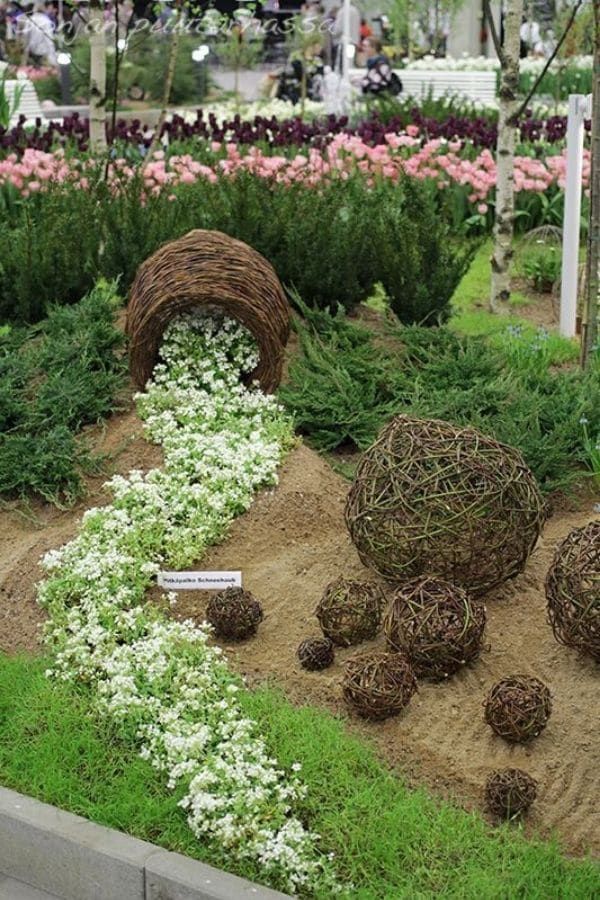When it comes to creating a successful vegetable garden, one often overlooked aspect is the importance of proper fencing. This crucial element serves as a protective barrier for your precious plants and can also add an aesthetic touch to your garden. In this article, we will explore various fencing ideas for vegetable gardens, including different types of materials, DIY options, accessories, and maintenance tips.
The choice of fencing material can greatly impact the overall look and functionality of your vegetable garden. Whether it’s wood, bamboo, wire, plastic, or other options, each material has its own set of pros and cons.
Factors such as height, durability, and aesthetic appeal should be carefully considered before making a final decision. By choosing the right fencing for your vegetable garden, you can effectively protect your plants from pests and harsh weather conditions while enhancing the overall visual appeal of your gardening space.
In addition to discussing the various types of fencing materials available, we will also provide step-by-step instructions for DIY fence building as well as explore different accessories such as gates, trellises, and decorative elements that can complement your vegetable garden fencing.
Furthermore, we will delve into the benefits of using fencing in vegetable gardens – from pest protection to providing support for vertical gardening – as well as offer inspiring examples of beautiful and functional fencing designs to spark creativity in your own garden.
Types of Fencing Materials for Vegetable Gardens
When it comes to choosing the right fencing for your vegetable garden, there are several options to consider in terms of materials. Each type of material has its own set of advantages and considerations, so it’s important to weigh these factors before making a decision.
Wooden fences are a popular choice for vegetable gardens due to their natural and rustic appeal. They can provide a classic look to the garden while also offering sturdy protection. Bamboo fencing is another environmentally-friendly option that adds a touch of exotic style to the garden. Both wood and bamboo can be versatile in terms of design, allowing for different heights and styles depending on the overall aesthetic you want to achieve.
On the other hand, wire and plastic fences offer practical benefits such as durability and low maintenance. Wire fencing can provide excellent protection against pests and animals, while plastic options are weather-resistant and easy to clean. These materials are often more affordable than wood or bamboo, making them a cost-effective solution for vegetable gardeners on a budget.
When choosing the right fencing material for your vegetable garden, it’s essential to consider factors such as height, durability, aesthetic appeal, and budget. Keep in mind that the chosen material should not only serve its functional purpose but also complement the overall look and feel of your vegetable garden. By carefully considering these factors, you can find the perfect fencing material that meets your specific needs and preferences for your garden space.
Considerations for Choosing the Right Fencing for Your Vegetable Garden
When it comes to choosing the right fencing for your vegetable garden, there are several important considerations to keep in mind. From height and durability to aesthetic appeal, the type of fence you choose can have a significant impact on the success of your garden. Here are some key factors to consider when selecting fencing for your vegetable garden:
1. Height: The height of your fencing is crucial for keeping out unwanted pests and animals that may damage your crops. It’s important to choose a fence that is tall enough to deter deer, rabbits, and other garden intruders.
2. Durability: Vegetable garden fencing needs to be durable enough to withstand the elements and potential wear and tear. Consider materials that are weather-resistant and long-lasting, such as treated wood or vinyl.
3. Aesthetic Appeal: While functionality is paramount, it’s also essential to consider the visual impact of your fencing. Choose a design that complements the overall look of your garden and enhances its beauty.
In addition to these considerations, it’s also important to think about the specific needs of your vegetable garden when selecting fencing materials. Whether you’re looking for a simple and practical solution or a decorative element that adds personality to your garden, there are countless options available when it comes to fencing ideas for vegetable gardens.
DIY Fencing Ideas for Vegetable Gardens
When it comes to protecting your vegetable garden, a well-built fence can make all the difference. Not only does it keep out unwanted pests and critters, but it can also add a touch of charm and personality to your outdoor space.
Building your own fence for your vegetable garden is not as daunting as it may seem, especially with the right guidance and materials. In this section, we will provide you with step-by-step instructions for creating your DIY fencing ideas for vegetable gardens.
Step 1: Planning and Preparation
Before you start building your fence, it’s important to have a clear plan in mind. Consider the layout of your garden, the dimensions of the area you want to enclose, and any specific design elements you want to incorporate. Once you have a solid plan in place, gather all the necessary tools and materials, including wood or bamboo posts, wire mesh or wooden slats, nails or screws, and any decorative elements you wish to add.
Step 2: Setting the Posts
The first step in building your vegetable garden fence is setting the posts. Use a post hole digger to create holes at regular intervals along the perimeter of your garden.
The depth of the holes will depend on the height of your fence – typically around 2 feet deep for shorter fences and up to 4 feet for taller ones. Place each post in its respective hole and use a level to ensure they are perfectly vertical before filling in the holes with concrete for stability.
Step 3: Installing the Panels
Once your posts are set in place, it’s time to install the fencing panels. If using wire mesh, attach it to each post using staples or wire ties. If opting for wooden slats, nail them horizontally across the posts at regular intervals until the entire perimeter is enclosed. Be sure to leave enough space between each panel for easy access into your garden and consider adding a gate if desired.
By following these step-by-step instructions for building your own fence, you can create a customized and functional barrier for your vegetable garden that suits both your practical needs and aesthetic preferences. Whether you choose wood or bamboo for a natural look, wire mesh for durability, or plastic for low-maintenance appeal, there are endless possibilities when it comes to DIY fencing ideas for vegetable gardens.
Fencing Accessories for Vegetable Gardens
When it comes to fencing ideas for vegetable gardens, it’s essential to consider the various accessories that can complement and enhance the functionality and aesthetic appeal of your fence. Gates, trellises, and decorative elements are all valuable additions that can elevate the overall look and performance of your vegetable garden fencing.
Gates are not only practical for providing access to your garden but also serve as a defining feature of your fence. Whether you opt for a simple wooden gate or a more elaborate wrought iron design, it’s important to choose a style that aligns with the overall theme of your garden. Additionally, consider the size of the gate to accommodate larger equipment for gardening tasks.
Trellises are another excellent addition to vegetable garden fencing, especially for vining crops such as tomatoes, cucumbers, and beans. These vertical structures provide support for plants to grow upward, maximizing space in the garden and making it easier to harvest produce. Trellises come in various materials such as wood, metal, or PVC, so select one that is durable and complements the look of your fence.
Incorporating decorative elements into your vegetable garden fencing can add personality and charm to the overall design. From ornamental finials and post caps to hanging planters and solar-powered lights, there are countless options to customize your fence. These decorative touches not only enhance the visual appeal of the garden but also contribute to creating a welcoming atmosphere for both you and your plants.
Benefits of Using Fencing in Vegetable Gardens
Using fencing in vegetable gardens offers a plethora of benefits that contribute to the overall success of your gardening efforts. From pest protection to vertical gardening support and privacy, the right fencing can make a significant difference in the health and productivity of your vegetable garden.
Pest Protection
One of the primary benefits of using fencing in vegetable gardens is the protection it provides against pests. Whether it’s rabbits, deer, or other animals, a well-constructed fence can prevent these critters from devouring your hard-earned harvest. Additionally, fencing can also keep out unwanted insects and birds that may damage your vegetables.
Vertical Gardening Support
Fencing can serve as an excellent support structure for vertical gardening in vegetable gardens. By attaching trellises or other climbing structures to the fence, you can grow vining crops such as tomatoes, cucumbers, and squash upwards, maximizing space and improving air circulation for healthier plants.
Privacy
In addition to its functional benefits, fencing can also provide privacy for your vegetable garden. Whether you simply want a secluded space for quiet relaxation or to shield your garden from prying eyes, the right fence can create a sense of seclusion and intimacy within your outdoor space.
Implementing fencing ideas for vegetable gardens not only enhances the aesthetic appeal but serves as a crucial element in protecting your crops while promoting healthy growth. Whether you prioritize protection from pests or creating a private oasis for your gardening endeavors, the strategic use of fencing will undoubtedly bolster the success of your vegetable garden.
Maintenance Tips for Vegetable Garden Fencing
Regular maintenance is essential to ensure the longevity and effectiveness of your vegetable garden fencing. By performing regular inspections, making necessary repairs, and weather-proofing your fences, you can protect your garden from pests and other potential threats.
Firstly, it’s important to perform regular inspections of your fencing to check for any signs of damage or wear. Look for loose boards or wires, rotten wood, rusted metal, or any other issues that may compromise the security of your garden. By addressing these issues early on, you can prevent larger problems from developing and keep your vegetable garden safe.
In addition to inspections, making prompt repairs to any damaged areas of the fencing is crucial. Whether it’s replacing a broken board, reinforcing weak spots, or patching up holes, taking care of these small repairs can make a big difference in the overall integrity of your fencing. This proactive approach can help to deter pests and animals from accessing your vegetables and ensure that your garden remains protected.
Furthermore, weather-proofing your vegetable garden fencing is essential for its long-term durability. Depending on the material used for your fence, applying a protective sealant or paint can help to prevent rotting, rusting, and other forms of damage caused by exposure to the elements. Additionally, investing in quality weather-resistant materials when building or repairing your fence can further contribute to its resilience against harsh weather conditions.
By implementing these maintenance tips for vegetable garden fencing – such as regular inspections, prompt repairs, and weather-proofing – you can ensure that your garden remains well-protected and looks its best throughout the growing season. Taking the time to care for your fences will ultimately contribute to the success of your gardening efforts and help provide a thriving environment for growing an abundance of fresh produce.
Inspiring Examples of Vegetable Garden Fencing Designs
When it comes to designing your vegetable garden fencing, there are countless creative and functional ideas to consider. The right fence not only serves as a practical barrier for your garden but can also add a beautiful aesthetic element to your outdoor space. From traditional wooden fences to modern trellises, the design options are endless.
One inspiring example of vegetable garden fencing is the use of reclaimed materials such as old doors, windows, or even metalwork. These unique elements can add a charming and eclectic look to your garden while also serving as a sustainable and environmentally-friendly choice. Additionally, using recycled materials can save on costs and provide an opportunity for creative DIY projects.
Another creative idea for vegetable garden fencing is the use of living fences such as hedges or espaliered fruit trees. Not only do these natural barriers provide privacy and create a beautiful backdrop for your garden, but they also offer added benefits such as attracting beneficial insects and birds while providing shade and wind protection for delicate plants.
For those looking for a more modern and minimalist design, consider incorporating sleek metal fencing or wire mesh panels into your vegetable garden. These materials offer durability and versatility while allowing for unique design opportunities such as vertical gardening or growing climbing vegetables like peas or beans.
These inspiring examples show that there are endless possibilities when it comes to choosing the right fencing for your vegetable garden. By thinking outside the box and considering both aesthetics and functionality, you can create a beautiful and productive outdoor space that reflects your personal style.
| Vegetable Garden Fencing Design | Description |
|---|---|
| Reclaimed Materials | Utilizing old doors, windows, or metalwork for an eclectic aesthetic with sustainable benefits. |
| Living Fences | Hedges or espaliered fruit trees provide natural beauty while attracting beneficial wildlife. |
| Metal Fencing/Wire Mesh Panels | Modern and minimalist options that offer durability and versatility. |
Conclusion
In conclusion, the type of fencing you choose for your vegetable garden can significantly impact the success of your gardening efforts. Whether you opt for wood, bamboo, wire, plastic, or another material, it’s crucial to consider factors such as height, durability, and aesthetic appeal when making your selection. By weighing these considerations and utilizing DIY fencing ideas for vegetable gardens, you can create a functional and visually appealing barrier to protect your crops.
Furthermore, incorporating fencing accessories like gates, trellises, and decorative elements can add not only practical benefits but also enhance the overall look of your garden. These elements not only serve as protection against pests but also provide vertical gardening support while adding an attractive visual element to your garden space. Through proper maintenance such as regular inspections, repairs, and weather-proofing, your fencing will continue to provide the necessary protection and support for your vegetables.
The examples of vegetable garden fencing designs showcased in this article underscore the myriad possibilities that exist when it comes to creating a beautiful yet functional barrier for your vegetable garden. With an understanding of the benefits and potential challenges associated with different fencing materials and designs, you can make an informed decision that will contribute to the success of your gardening endeavors.
Remember that with careful planning and attention to detail when selecting and maintaining your fence system, you can enjoy a thriving vegetable garden while enhancing the overall aesthetic appeal of your outdoor space.
Frequently Asked Questions
What Type of Fencing Is Best for Vegetable Garden?
The best type of fencing for a vegetable garden is typically one that keeps out animals, such as rabbits and deer, while also providing support for climbing plants. A popular option is wire mesh fencing with small openings to prevent animals from squeezing through.
What Is the Best Barrier for a Vegetable Garden?
The best barrier for a vegetable garden depends on the specific pests you’re trying to keep out. For small animals like rabbits and groundhogs, a fence made of chicken wire or hardware cloth may be effective. To protect against larger animals like deer, a taller fence made of wood or metal may be necessary.
How Do You Fence a Vegetable Garden?
Fencing a vegetable garden involves first determining the size and layout of the garden area. Then, choose the appropriate materials for your specific needs, such as wooden posts and wire mesh fencing for smaller animals, or sturdier materials for larger pests like deer.
Proper installation to ensure that there are no gaps or spaces that animals can squeeze through is also crucial. Additionally, creating a gate for easy access to the garden while still keeping it secure is important in the fencing process.

Welcome to my gardening blog! I am passionate about plants and enjoy sharing my knowledge and experiences with others. In this blog, I will write about everything related to gardening, from tips on how to get started to updates on my own garden projects.





